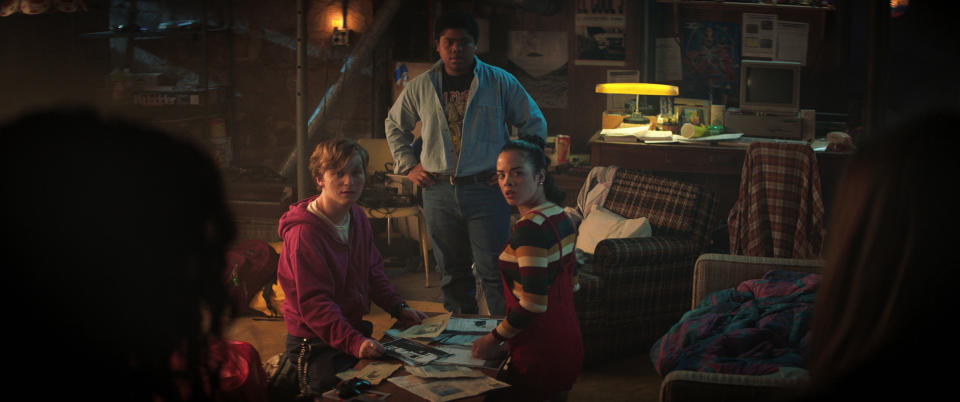‘Fear Street’: Why Netflix’s Horror Trilogy Is Built Around an ‘Underrepresented’ Queer Love Story

[Editor’s note: The following post contains light spoilers for “Fear Street Part 1: 1994.”]
Romances tend to not last too long in slasher films. There is, after all, a reason why the most consistent survival trope in horror films is “the final girl,” not “the final couple.” But it doesn’t have to be that way. Filmmaker Leigh Janiak gets that, and while her ambitious, time-spanning “Fear Street” trilogy giddily unpacks and twists all manner of horror ideas, finding a new way into a central love story is perhaps its most subversive concept.
More from IndieWire
'I Think You Should Leave' Season 2 Review: Tim Robinson Returns, Weirder and More Ambitious
'Naomi Osaka' Trailer: Garrett Bradley's Netflix Docuseries on the Tennis Superstar and Activist
Janiak’s three “Fear Street” films, rolling out on Netflix over the next three weeks, are based on R.L. Stine’s YA horror novels of the same name and, like Stine’s books, don’t treat its teen audience or characters with kid gloves. That extends into both the gore level (high, and more on that to come) and the honesty with which it tackles even the non-scary stuff, like its love stories, including a queer relationship that endures across three entire films.
At the heart of the trilogy is the relationship between Deena (Kiana Madeira) and Sam (Olivia Scott Welch), former girlfriends recently torn apart by Sam’s meddling mom and Sam’s move to tony Sunnyvale from the more downmarket Shadyside. Without spoiling what follows in the series, we’ll say this: Deena and Sam’s love story is key to the entire series, and emblematic of both the fresh spin Janiak puts on the stories and the classic sense of “otherness” often found in the genre’s greatest heroes.
“There’s been a million slasher movies,” Janiak said in a recent interview with IndieWire. “We saw them in the ’70s and ’80s, and then the ’90s reinvented it. Part of it was, how do we have a way into doing slashers but also making it feel like, oh, there’s a reason we’re revisiting this genre? For me, that was about trying to tell stories about people that normally would not have been highlighted, even though, obviously, they existed. There were queer people in the ’90s and ’80s and ’70s. There were Black people. There was a whole swath of people that are underrepresented in horror movies or die very quickly! That was an exciting part of the trilogy to me and built into why I wanted to make the movies.”
Janiak’s films are populated by all sorts of young characters, including bi-racial Deena and her brother Josh (Benjamin Flores Jr.), who might normally be the first ones killed in a more traditional slasher. Those are the people Janiak wanted to put center stage, a concept aided by the persistent sense that Shadyside’s residents are somehow doomed, cursed, and otherwise not long for this world. They feel “other” for many reasons, and that was compelling to Janiak.
“As we started to break down the narrative across the three films, it made sense that everyone in Shadyside feels ‘other’ and feels like they’ve been told by the world that they’re not good enough for whatever reason, whether or not it has to do with race or sexuality or socioeconomic status or whatever it is,” she said. “They’ve felt like the world is against them. As we built out from that, it made sense that our central love story that was pushing us forward was one that wasn’t represented very often, and was a queer love story.”
Horror aside, Janiak was also drawn to the relatable nature of Deena and Sam’s romance. The girls love each other, but just can’t seem to make things work — something that Janiak expects will speak to a wide audience.
Netflix
“There was something very appealing to me about these two girls who love each other but aren’t necessarily on the same page right away,” Janiak said. “It’s not a perfect thing. They’re still figuring it out. I think that feels very relatable.”
Janiak also pointed to her longtime writer partner, Phil Graziadei, who is gay, as being particularly adept at making Deena and Sam’s love story feel both specific and universal. “He was amazing about keeping us focused, so that we were telling this story — which feels universal, everyone has had some kind of shade of love — but he was also always reminding us that being queer in the ’90s is different than what it means now. There’s a different, very specific experience that is not the same as what it is to just be straight and in love. It was cool to be able to balance that and keep it very queer, but also find those things that I think everyone responds to.”
For fans of Janiak’s debut film, the chilling 2014 indie hit “Honeymoon,” the filmmaker’s affection for big, bold romances stuck in the middle of horrifying circumstances will likely feel familiar. No one, even the characters she loves the most, is safe. “I just love love stories,” she added with a laugh. “I just love them, even though I also like to destroy them.”
“Fear Street Part 1: 1994” is now streaming on Netflix. “Fear Street Part 2: 1978” hits the streamer on July 9, with “Fear Street Part 3: 1666” following on July 16.
Best of IndieWire
New Movies: Release Calendar for July 2, Plus Where to Watch the Latest Films
As the Blockbuster Box Office Vrooms Back to Life, What Will Be the Next Specialty Hit?
Sign up for Indiewire's Newsletter. For the latest news, follow us on Facebook, Twitter, and Instagram.


